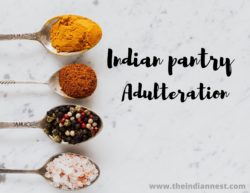
Indian pantry adulteration is main thing we should know. Do you know that food we eat is safe?
Daily we bring groceries to feed our family. In my last post, I had shared some tips and tricks to shopping pantry and groceries.
So we must check whether the things we bought are worth it. All money we spend should not get wasted. Mainly in Indian kitchens, we use a variety of ingredients in our everyday life.
What Is Food Adulteration?
Food Adulteration reduces the quality of food items by adding harmful substances or taking quality things from them.
Sellers do this to make more money. We, the consumers, don’t know and consume adultered food without realizing it.
Now, you don’t want to worry much.
Here I got commonly seen Indian pantry adulteration in the Indian food industry.

Spices
In our Indian kitchen, spices are the essential cooking ingredient. Powdered spices available in the market are often contaminated with harmful colors and other weight-gaining agents like chalk powder.
I would explain one by one about our spices adultering agents in our Indian market. One good thing is that you can test quickly in your kitchen.
Turmeric powder

Chalk powder, lead chromate, metal yellow are the most common In Indian pantry adulterant in turmeric powder.
For the test
- You can add a teaspoon of turmeric to a glass of warm water. Set aside it for a while, then check after 20 minutes.
- The turmeric is pure if the powder settles down at the bottom of the glass with clear water.
- Cloudy water indicates possible adulteration.
Red Chilli powder

In red chili powder, artificial color, brick powder are the main impurities.
For the test
- Same as the turmeric powder test, you can take one teaspoon of chili powder to a glass of water and mix it.
- After some time, you can see a whirl of bright red color, which means it contains artificial color.
- If you can see sandy sediment at the bottom of the glass, it has dust/ brick powder.
Corriander powder
Hust (outer shell or coating of a seed) is the main adulterant in the coriander powder.
For the test
- Add a teaspoon of coriander powder to a glass of water and stir.
- After a while, you can see husk will start floating on the surface while the pure spice will settle at the glass’s bottom.
Cumin seeds/fennel seeds
The primary contaminants are charcoal dust, Starch, and sawdust.
Do the same test of chilly powder.
Black pepper

Dry papaya seeds are commonly seen as an adulterant.
For the test
- Add your peppercorns to a bowl of alcohol; the papaya seeds will sink while the natural corns will stay on the top.
Sugar/ Salt
Chalk powder is mainly seen in sugar and salt.
For the test
Stir in a spoon of salt/ sugar in a glass of water. If the solution turns white and a residue settles at the bottom, it means chalk. A straightforward solution indicates purity.
Milk

You can easily spot natural milk and synthetic milk.
First, let us talk about natural milk.
Natural Milk
Natural milk tastes slightly sweet, white in color; the texture will be no soapy feeling if rubbed between fingers.
After heating, natural milk remains white—no change in color of effect on storage.
If natural milk contains urea, it may be light yellow.
Synthetic Milk
Synthetic milk tastes slightly sweet and white in colour. You may feel a soapy feeling if rubbed between fingers. It turn yellowish when boils. It may turn intense yellow after sometime.
Starch and detergent are the main adulterants.
Test for Starch:
Take a small sample of milk with little water and bring it to a boil. Then after it’s room temperature, take the sample in transparent glass and add a drop or two of iodine solution.
A blue color solution indicates the presence of Starch.
Test for Detergent:
This is a simple test; you may need to shake the milk sample vigorously.
You can see milk adulterated with detergent will form a dense lather, while pure dairy will have a thin layer of foam.
Ghee
The main adulterant in ghee are vanaspati, vegetable oil, Starch
Test for ghee:
Melt a small quantity of ghee. Pour it into a glass jar or container and place it in the fridge till it solidifies.
The pressure of separate layers indicates the presence of other oils.
Oils
Mustard oil
Take a small amount of mustard oil in transparent glass and add a few drops of nitric acid to it. Shake it and heat the mixture for 2-3 minutes. The red color is formed due to the presence of argemone oil.
Coconut oil
Take a sample of the coconut oil in a glass jar or bowl and place it in the fridge for 30 minutes. If the coconut oil is pure, the entire sample will solidify. You can see other oils will be seen as a separate layer if the model is adulterated.
Pulses

Artificial colors are the foremost common adulterants.
You can check the purity of pulses by grinding some pulses to get a powdery texture.
Add warm water to it if you see a bright yellow color, then it determines the presence of artificial colors.
Green peas, green chilies, and other green vegetables
Adulterant: Malachit green.
Test: Place a sample of green peas over a moistened white blotting paper. Then green colored impressions on the blotting paper indicate the presence of malachite green.
Honey

Adulterant: Glucose/ sugar syrup, high fructose concentrated sugar.
Test: This is a simple test you can do by adding spoonful of honey to a glass of water. If the honey disperses instantly, it indicates the presence of glucose/sugar syrup.
Pure honey is denser and will form like a thread and will sink bottom instead of dissolving.
Rice
Common adulterants: Pebble, damaged grains, and polish.
Test: If your rice is polished, you can clearly tell that by just looking at its shine.
Another simple way is to soak rice in water, and if the water turn colored (brown/white), then it is polished.
A simple test you can do now at home

These are some common Indian pantry adulteration you can see in the market.
- Move a magnet through your flour, tea powder to check for iron fillings.
- Mix a small amount of milk and water and shake it vigorously. If adulterated with detergent, the solution will form a lather.
- Refrigerate coconut oil for 30 minutes. Coconut oil freezes; any other adulterant will stay on top as a separate layer.
- Asafoetida, when burned in a small spoon, it burns like camphor; if adulterated, it will not produce a bright flame.
- Cut a piece of potato and sprinkle salt on it. Please wait for a minute and add two drops of lemon juice to it. If it is iodised salt, the blue colour will develop.
- Add coffee powder to water and stir. If the coffee powder is adulterated, you can see clay and chicory moving to the bottom and will settle.
- For vegetables like ladies’ finger, green chilies, and sweet potato, rub a piece of cotton soaked in vegetable oil on its surface. If coloured, you can see the cotton catch colour.
Tips to avoid adulteration
According to the National Health Service and Food Research Institute, several food products have been adulterated to increase the quantity and make more profit. Adding adulterants to food products is quite common in all developing countries and other backward countries.
Here are specific safety tips to avoid adulteration:
- Avoid dark-coloured, junk, and other processed foods.
- Make sure to clean and store all the grains, pulses, and other food products.
- Wash your fruits and vegetables thoroughly in running water before consuming them.
- Check if the seal is valid or not before buying food products like milk, oil, and other pouches.
- Always make sure to check and buy products having an FSSAI-validated label, along with the license number, list of ingredients, manufactured date, and its expiration.
So these are the common food adulteration which is seen in our country. Always look while grocery shopping and take the best product.
I hope you got all the information regarding food adulteration or pantry adulteration.
with
❤️
Nasreen

Don’t FORGET to pin this for later!
Follow me on Pinterest!


 Block Scheduling Secret of Highly Productive People
Block Scheduling Secret of Highly Productive People
Thank you for sharing this valuable piece of information! It’s very helpful in today’s time. In my case, 99% of times I use whole spices or I grind them myself as needed. But for milk, honey, veggies I’m not able to find better quality products. Thanks again! Lovely blog! Great details! Helpful topics!
Thank you so much Mansi for your valuable feedback! As you told before same here for whole spices,I make it myself.I bring freshly prepared masala powders such as turmeric, coriander, chilly etc from my native. For Honey you can buy bonphool natural mangrove honey from amazon it’s so good without any adulterants and you will love it. Don’t know what to do with veggies?. So glad to see your comments.
Happy Blogging